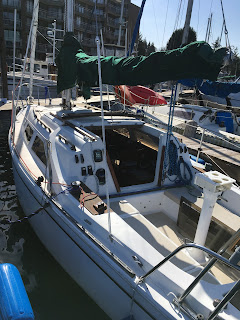Doing double duty ...
The running backstays I fabricated out of Dyneema are normally attached on the outer sides of the cockpit coaming with lashings that run through D-rings and are tightened and secured with small cleats. Their primary purpose is to support the mast at the point where the sail’s head load is (at times) transferred through the yard-spar to the mast’s battcar & T-track assembly.
When I was out on my last sail, I started wondering if they might also serve as temporary lazy jacks when sailing in the fore-and-aft configuration. Lazy jacks are great when lowering the mainsail as they prevent the sail from spilling all over the deck as it comes down. The potential snafu is that they can snag the sail’s battens as it’s raised, possibly damaging the fabric. What if you had lazy jacks could magically appear AFTER the mainsail has already been raised? Quelle magnifique idée!
After a trip to Fisheries to acquire the necessary bits of hardware and fasteners, I luggage tagged the lashing lines to each running backstay and started temporarily attaching the line assembly to various points of the boom and mast to see what the ideal configuration might be. I came up with my best WAG, took a breath and started drilling and tapping holes. After attaching the line guides and cleats, I did a dry run at the dock and it looked like it might work, but since the wind was coming from the wrong direction and at too great a velocity I couldn’t actually raise the mainsail at the dock.
Later that week was a perfect day for a late winter sail: sunny, relatively warm with winds 5-15 knots. Let’s go try it out! Once away from the dock, the mainsail was raised and on successive tacks, each side of the “running lazyjack” setup was quickly installed. Here’s a brief description: the Dyneema line is attached to a spring clip which itself is attached mid-boom; the lashing line is run through the line guide about 7 feet up the mast, then secured to a cleat on the forward part of the boom. This is what it looks like when all is complete:
Lowering the mainsail is now a cinch; the sail nestles securely between the two lazyjacks as it comes down. Then, at my leisure, when it’s convenient, I can go forward and secure the sail with the bungee ties. Back at the dock, the running lazyjack setup can be undone, the lashings removed, and the Dyneema running backstay secured. This will make life as a single-handed sailor much easier! You do need to leave enough slack in the lazyjacks so that they don’t prevent the mainsail from properly inflating and achieving the desired draft/draught.
NOTE: I have since modified this lazy jack setup; I did away with the lashing lines and now have short lines with quick connects running from the cleats up to loops lashed to the running backstays. It’s much easier to setup and takedown, and just as effective.








